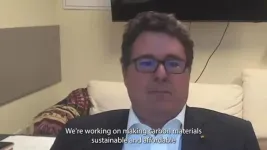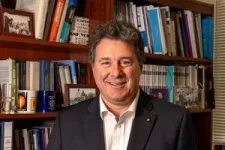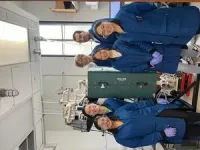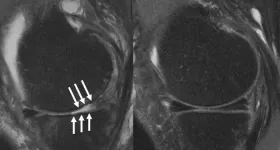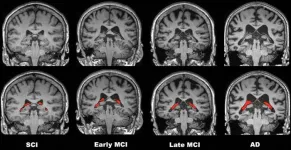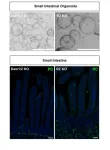(Press-News.org) HOUSTON – (Nov. 27, 2023) – An international team of scientists led by Rice University’s Matteo Pasquali has won a $4.1 million grant to optimize carbon nanotube synthesis, a process that could help drive the green energy transition by providing more sustainable alternatives to materials dependent on heavy industry. The award is a joint effort by The Kavli Foundation, with a $1.9 million Kavli Exploration Award in Nanoscience for Sustainability, and Rice’s Carbon Hub, which contributed an additional $2.2 million.
“The energy transition is primarily a material transition,” Pasquali said. “Renewable energy and electrification have a much larger material footprint than their counterpart fossil-based technologies. We need to break out of the current mindset that the energy systems of the future can be built with materials developed before chemistry became a mature science. We can now do this because we can control the structure and properties of solid carbon with an unprecedented degree of precision.”
Carbon nanotubes, or CNTs, are hollow cylindrical nanoscale structures made from carbon atoms. Their properties ⎯ excellent carriers of heat and electricity; very strong, though lightweight and with large surface area ⎯ make them useful in electronics, biosensors, batteries and more. In theory, they constitute an ideal net-zero end use for hydrocarbons such as natural gas, with the added benefit of hydrogen as a reaction byproduct. However, large-scale CNT synthesis still poses a challenge, one that Pasquali and his team hope their project will help address.
“We are at a critical juncture in carbon research, and it is really important that we shed light on the physical and chemical processes that drive CNT synthesis,” Pasquali said. “Currently, reactors are black boxes, which prevents us from ramping up synthesis efficiency. We need to better understand the forces at play in CNT formation by developing new tools to shed light on the reaction zone and find ways to leverage it to our advantage.”
Rice has a longstanding record of discovery and innovation in carbon research, spanning from Robert Curl and Richard Smalley’s 1996 Nobel Prize for their “discovery of carbon atoms bound in the form of a ball” to the present. Building on this history, Pasquali helped spearhead the establishment of the Carbon Hub, a coalition of corporations, academic and research institutions and nonprofit organizations aligned by the common goal of decarbonizing the economy.
“The research community has been making CNTs for years, but initially we’ve focused on getting properties on a small scale,” Pasquali said. “Once we attained properties, we also realized there is no intrinsic reason why we couldn’t be making these materials on a much larger scale. It became immediately obvious just how critical doing so could be for the green energy transition.”
According to Pasquali, in order to scale up CNT synthesis, a piecemeal, fragmented approach to the research is insufficient. Instead, the task calls for collaboration across disciplines, including ones that were not involved during the first wave of research and development. Because CNT synthesis evolved in multiple countries simultaneously, this called for the establishment of an international research collaboration.
“We have to apply a collaborative mindset to solve this problem,” Pasquali said. “We believe that by bringing together a dedicated interdisciplinary community, this project will lead to improvements in reactor efficiency and help identify further gaps in instrumentation and modeling.”
The Kavli Foundation, established in 2000 by Norwegian-American engineer and entrepreneur Fred Kavli, has emerged as a leading institution in promoting science advancements by supporting research in astrophysics, nanoscience, neuroscience and theoretical physics. Driven by a vision “to advance science for the benefit of humanity,” the foundation funds basic research in these four fields through partnerships, initiatives and portfolios designed to push the boundaries of science. This grant is part of its Nanoscience for Sustainability program, which seeks to unlock technologies of the future through innovation in materials research.
In addition to supporting basic research, The Kavli Foundation, in partnership with The Norwegian Academy of Science and Letters and The Norwegian Ministry of Education and Research, also established The Kavli Prize, honoring scientific breakthroughs “that transform our understanding of the natural world,” according to the foundation website. Many recipients of The Kavli Prize go on to win a Nobel Prize.
“We are proud to partner with Rice University to support this important high-risk, high-reward research,” said Amy Bernard, director of life sciences at The Kavli Foundation.
“The collaboration with The Kavli Foundation will allow individual teams working on the project to come together and work in a coordinated fashion,” said Pasquali, Rice’s A.J. Hartsook Professor of Chemical and Biomolecular engineering and professor of chemistry and materials science and nanoengineering and director of the Carbon Hub. “We are really excited about the breakthrough potential of this kind of exploratory approach that will allow us to include scientists working on complementary areas that are typically not involved in CNT research.”
Pasquali added that CNT synthesis is only part of a larger effort, facilitated by the Carbon Hub, to assemble a new material supply chain.
“When you want to replace a bridge made of stone with one made of steel, you don’t just replicate the same structure ⎯ you have to redesign the arch bridge and come up with the suspension bridge concept,” he said. “Synthesis is the cornerstone of this new supply chain, but other efforts need to be coordinated so that the material can be tried and deployed as pervasively as we do for metals and other industrial materials.”
In addition to Pasquali, Rice researchers involved in the project include Boris Yakobson, the Karl F. Hasselmann Professor of Engineering and professor of materials science and nanoengineering, and Thomas Senftle, assistant professor of chemical and biomolecular engineering.
The collaboration includes Adam Boies at University of Cambridge; Mauro Bracconi, Matteo Maestri and Matteo Pelucchi at Politecnico di Milano; Matteo Cargnello and Arun Majumdar at Stanford University; Phillip Christopher and Eric McFarland at UC Santa Barbara; Sili Deng at Massachusetts Institute of Technology; Chris Hogan and Marien Simeni at University of Minnesota; Christian Reece at Harvard University; Eric Stach at University of Pennsylvania; Mauricio Terrones at Pennsylvania State University; Jeff Blackburn of the National Renewable Energy Laboratory; Jeff Fagan of the National Institute of Standards and Technology; Seung Min Kin of the Korea Institute of Science & Technology; Benji Maruyama of the Air Force Research Laboratory; Raghu Sivaramakrishnan of Argonne National Laboratory; and Juan Jose Vilatela of the Madrid Institute for Advanced Studies, Materials.
-30-
This release can be found online at news.rice.edu.
Follow Rice News and Media Relations via Twitter @RiceUNews.
Video:
URL: https://youtu.be/qCLuNV03heI (Video by Katie McKissick/The Kavli Foundation)
Image downloads:
https://news-network.rice.edu/news/files/2023/11/231114_Matteo-Pasquali_Gustavo-2.jpg
CAPTION: Matteo Pasquali is Rice’s A.J. Hartsook Professor of Chemical and Biomolecular Engineering, professor of chemistry and materials science and nanoengineering and director of the Carbon Hub (Photo by Gustavo Raskosky/Rice University)
https://news-network.rice.edu/news/files/2023/11/Reactor-team-photo-2.jpg
CAPTION: Muxiao Li (top row, from left), Eldar Khabushev, Davide Cavuto, Jui Junnarkar (bottom row, from left), Mingrui (Lily) Gong and Ana Victoria Benavides-Figueroa (Photo courtesy of the Pasquali Research Group/Rice University)
https://news-network.rice.edu/news/files/2023/11/231114_Matteo-Pasquali_Gustavo-13.jpg
CAPTION: Muxiao Li (left) and Matteo Pasquali (Photo by Gustavo Raskosky/Rice University)
https://news-network.rice.edu/news/files/2023/11/Rice-CNTs-SEM3-1.jpg
CAPTION: Scanning electron microscope image of carbon nanotubes. (Photo courtesy of the Pasquali Research Group/Rice University)
Links:
Carbon Hub: https://carbonhub.rice.edu/
Pasquali Research Group: https://pasquali.rice.edu/
Yakobson Research Group: https://biygroup.blogs.rice.edu/
Senftle Research Group: https://senftle.blogs.rice.edu/
Department of Chemical and Biomolecular Engineering: https://chbe.rice.edu/
Department of Materials Science and NanoEngineering: msne.rice.edu
George R. Brown School of Engineering: https://engineering.rice.edu
About Rice:
Located on a 300-acre forested campus in Houston, Rice University is consistently ranked among the nation’s top 20 universities by U.S. News & World Report. Rice has highly respected schools of architecture, business, continuing studies, engineering, humanities, music, natural sciences and social sciences and is home to the Baker Institute for Public Policy. With 4,574 undergraduates and 3,982 graduate students, Rice’s undergraduate student-to-faculty ratio is just under 6-to-1. Its residential college system builds close-knit communities and lifelong friendships, just one reason why Rice is ranked No. 1 for lots of race/class interaction, No. 2 for best-run colleges and No. 12 for quality of life by the Princeton Review. Rice is also rated as a best value among private universities by Kiplinger’s Personal Finance.
END
Kavli Exploration Award backs Rice-led sustainable carbon materials research
The Kavli Foundation, Rice’s Carbon Hub award $4M to multidisciplinary CNT synthesis project
2023-11-27
ELSE PRESS RELEASES FROM THIS DATE:
Mixing heat with hair styling products may be bad for your health
2023-11-27
Hair products often contain ingredients that easily evaporate, so users may inhale some of these chemicals, potentially posing health repercussions. Now, researchers have studied emissions of these volatile organic compounds (VOCs), including siloxanes, which shine and smooth hair. The scientists report in ACS’ Environmental Science & Technology that using these hair care products can change indoor air composition quickly, and common heat styling techniques — straightening and curling — increase VOC levels even more.
Some ...
Stronger thigh muscles may prevent knee replacement surgery
2023-11-27
CHICAGO – Stronger quadriceps muscles, relative to the hamstrings, may lower the risk of total knee replacement, according to research being presented today at the annual meeting of the Radiological Society of North America (RSNA). Researchers said the findings could inform strength-training programs for people with advanced arthritis in the knee.
Advanced knee osteoarthritis is a major cause of pain and disability worldwide. In the U.S. alone, 14 million adults have symptomatic knee osteoarthritis, and more than half of those diagnosed are projected to eventually undergo total knee replacement surgery.
While stronger muscle groups are generally understood ...
Black patients face delays in Alzheimer’s diagnosis
2023-11-27
CHICAGO – Black patients underwent medical imaging for cognitive impairment years later than white and Hispanic patients and were less frequently tested with MRI, according to research being presented this week at the annual meeting of the Radiological Society of North America (RSNA).
Previous studies have shown that Black patients are at increased risk of Alzheimer’s disease and other types of dementia. They are less likely to have a diagnosis and are diagnosed at a more advanced stage of disease compared to white patients.
Medical ...
Patient support programs for prescription drugs are common, especially for expensive drugs
2023-11-27
About 1 in 10 prescription drugs — mainly brand-name and expensive drugs and those for rare diseases — has a manufacturer-sponsored patient support program, which usually includes financial, nursing and educational supports.
"In an era where policy-makers are grappling with escalating drug prices and budgetary impacts globally, the pharmaceutical industry promotes patient support programs as adding complementary value to a drug through supporting medication adherence and enhancing clinical outcomes, patient experience or quality of life," ...
Secrecy at Canada's pest management agency must end
2023-11-27
Health Canada increased maximum residue limits for glyphosate in some crops, such as oats and beans, in 2021 despite concerns about the health impact of glyphosate-based herbicides (GBHs). The World Health Organization's (WHO) International Agency for Research on Cancer regards these pesticides as genotoxic, meaning they can damage DNA and are likely carcinogenic.
"Health Canada's PMRA considers pesticide sales and risk evaluation data in Canada to be confidential business information, and independent researchers cannot access these data, even through the Access to Information Act. Such ...
Decoding cell fate: Key mechanism in stem cell switch identified
2023-11-24
Stem cells can differentiate to replace dead and damaged cells. But how do stem cells decide which type of cell to become in a given situation? Using intestinal organoids, the group of Bon-Kyoung Koo at IMBA and the Institute for Basic Science identified a new gene, Daam1, that plays an essential role, switching on the development of secretory cells in the intestine. This finding, published on November 24 in Science Advances, opens new perspectives in cancer research.
Our bodies are, in some ways, like cars – to keep functioning, they need to be checked and repaired regularly. In the case of our bodies, ...
The Fens of eastern England once held vast woodlands, study finds
2023-11-24
The Fens of eastern England, a low-lying, extremely flat landscape dominated by agricultural fields, was once a vast woodland filled with huge yew trees, according to new research.
Scientists from the University of Cambridge studied hundreds of tree trunks, dug up by Fenland farmers while ploughing their fields. The team found that most of the ancient wood came from yew trees that populated the area between four and five thousand years ago.
These trees, which are a nuisance when they jam farming equipment during ploughing, contain a treasure trove of perfectly preserved ...
Premature death of autistic people in the UK investigated for the first time
2023-11-24
A new study led by UCL researchers confirms that autistic people experience a reduced life expectancy, however the number of years of life lost may not be as high as previously claimed.
The research, published in The Lancet Regional Health – Europe, is the first to estimate the life expectancy and years of life lost by autistic people living in the UK.
The team used anonymised data from GP practices throughout the UK to study people who received an autism diagnosis between 1989 to 2019. They ...
How do plants determine where the light is coming from ?
2023-11-23
Plants have no visual organs, so how do they know where light comes from? In an original study combining expertise in biology and engineering, the team led by Prof Christian Fankhauser at UNIL, in collaboration with colleagues at EPFL, has uncovered that a light-sensitive plant tissue uses the optical properties of the interface between air and water to generate a light gradient that is 'visible' to the plant. These results have been published in the journal Science.
The majority of living organisms (micro-organisms, plants and animals) have the ability to determine the origin of a light source, even in the absence of a sight organ comparable to the eye. This information is invaluable ...
Study provides fresh insights into antibiotic resistance, fitness landscapes
2023-11-23
E. coli bacteria may be far more capable at evolving antibiotic resistance than scientists previously thought, according to a new study published in Science on November 24.
Led by SFI External Professor Andreas Wagner, the researchers experimentally mapped more than 260,000 possible mutations of an E. coli protein that is essential for the bacteria’s survival when exposed to the antibiotic trimethoprim.
Over the course of thousands of highly realistic digital simulations, the researchers then found that 75% of all possible evolutionary paths of the E. coli protein ultimately ...
LAST 30 PRESS RELEASES:
Scientists trace microplastics in fertilizer from fields to the beach
The Lancet Obstetrics, Gynecology, & Women’s Health: Taking paracetamol during pregnancy does not increase risk of autism, ADHD or intellectual disabilities, confirms new gold-standard evidence review
Taking paracetamol during pregnancy does not increase risk of autism, ADHD or intellectual disabilities
Harm reduction vending machines in New York State expand access to overdose treatment and drug test strips, UB studies confirm
University of Phoenix releases white paper on Credit for Prior Learning as a catalyst for internal mobility and retention
Canada losing track of salmon health as climate and industrial threats mount
Molecular sieve-confined Pt-FeOx catalysts achieve highly efficient reversible hydrogen cycle of methylcyclohexane-toluene
Investment in farm productivity tools key to reducing greenhouse gas
New review highlights electrochemical pathways to recover uranium from wastewater and seawater
Hidden pollutants in shale gas development raise environmental concerns, new review finds
Discarded cigarette butts transformed into high performance energy storage materials
Researchers highlight role of alternative RNA splicing in schizophrenia
NTU Singapore scientists find new way to disarm antibiotic-resistant bacteria and restore healing in chronic wounds
Research suggests nationwide racial bias in media reporting on gun violence
Revealing the cell’s nanocourier at work
Health impacts of nursing home staffing
Public views about opioid overdose and people with opioid use disorder
Age-related changes in sperm DNA may play a role in autism risk
Ambitious model fails to explain near-death experiences, experts say
Multifaceted effects of inward foreign direct investment on new venture creation
Exploring mutations that spontaneously switch on a key brain cell receptor
Two-step genome editing enables the creation of full-length humanized mouse models
Pusan National University researchers develop light-activated tissue adhesive patch for rapid, watertight neurosurgical sealing
Study finds so-called super agers tend to have at least two key genetic advantages
Brain stimulation device cleared for ADHD in the US is overall safe but ineffective
Scientists discover natural ‘brake’ that could stop harmful inflammation
Tougher solid electrolyte advances long-sought lithium metal batteries
Experts provide policy roadmap to reduce dementia risk
New 3D imaging system could address limitations of MRI, CT and ultrasound
First-in-human drug trial lowers high blood fats
[Press-News.org] Kavli Exploration Award backs Rice-led sustainable carbon materials researchThe Kavli Foundation, Rice’s Carbon Hub award $4M to multidisciplinary CNT synthesis project
